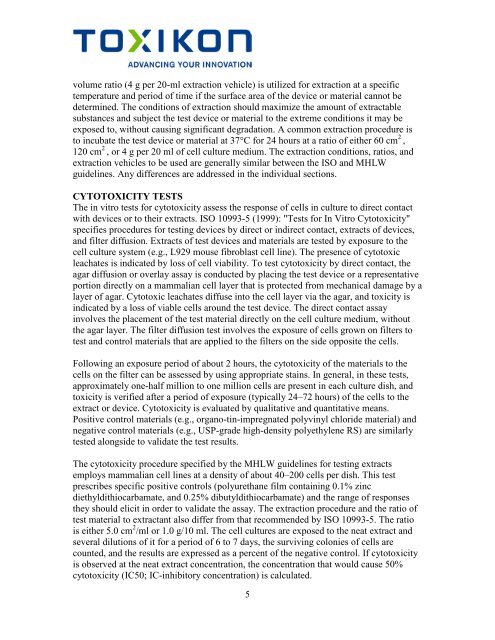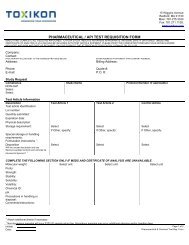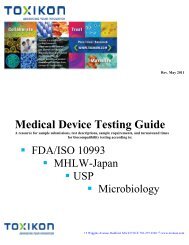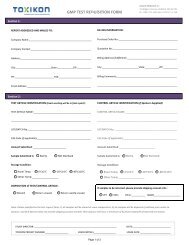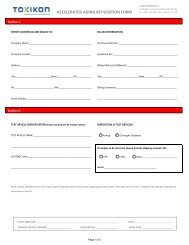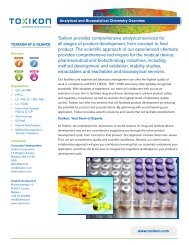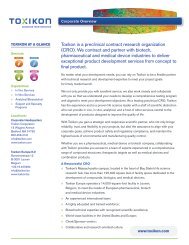Biocompatibility Safety Assessment of Medical Devices ... - Toxikon
Biocompatibility Safety Assessment of Medical Devices ... - Toxikon
Biocompatibility Safety Assessment of Medical Devices ... - Toxikon
Create successful ePaper yourself
Turn your PDF publications into a flip-book with our unique Google optimized e-Paper software.
volume ratio (4 g per 20-ml extraction vehicle) is utilized for extraction at a specific<br />
temperature and period <strong>of</strong> time if the surface area <strong>of</strong> the device or material cannot be<br />
determined. The conditions <strong>of</strong> extraction should maximize the amount <strong>of</strong> extractable<br />
substances and subject the test device or material to the extreme conditions it may be<br />
exposed to, without causing significant degradation. A common extraction procedure is<br />
to incubate the test device or material at 37°C for 24 hours at a ratio <strong>of</strong> either 60 cm 2 ,<br />
120 cm 2 , or 4 g per 20 ml <strong>of</strong> cell culture medium. The extraction conditions, ratios, and<br />
extraction vehicles to be used are generally similar between the ISO and MHLW<br />
guidelines. Any differences are addressed in the individual sections.<br />
CYTOTOXICITY TESTS<br />
The in vitro tests for cytotoxicity assess the response <strong>of</strong> cells in culture to direct contact<br />
with devices or to their extracts. ISO 10993-5 (1999): "Tests for In Vitro Cytotoxicity"<br />
specifies procedures for testing devices by direct or indirect contact, extracts <strong>of</strong> devices,<br />
and filter diffusion. Extracts <strong>of</strong> test devices and materials are tested by exposure to the<br />
cell culture system (e.g., L929 mouse fibroblast cell line). The presence <strong>of</strong> cytotoxic<br />
leachates is indicated by loss <strong>of</strong> cell viability. To test cytotoxicity by direct contact, the<br />
agar diffusion or overlay assay is conducted by placing the test device or a representative<br />
portion directly on a mammalian cell layer that is protected from mechanical damage by a<br />
layer <strong>of</strong> agar. Cytotoxic leachates diffuse into the cell layer via the agar, and toxicity is<br />
indicated by a loss <strong>of</strong> viable cells around the test device. The direct contact assay<br />
involves the placement <strong>of</strong> the test material directly on the cell culture medium, without<br />
the agar layer. The filter diffusion test involves the exposure <strong>of</strong> cells grown on filters to<br />
test and control materials that are applied to the filters on the side opposite the cells.<br />
Following an exposure period <strong>of</strong> about 2 hours, the cytotoxicity <strong>of</strong> the materials to the<br />
cells on the filter can be assessed by using appropriate stains. In general, in these tests,<br />
approximately one-half million to one million cells are present in each culture dish, and<br />
toxicity is verified after a period <strong>of</strong> exposure (typically 24–72 hours) <strong>of</strong> the cells to the<br />
extract or device. Cytotoxicity is evaluated by qualitative and quantitative means.<br />
Positive control materials (e.g., organo-tin-impregnated polyvinyl chloride material) and<br />
negative control materials (e.g., USP-grade high-density polyethylene RS) are similarly<br />
tested alongside to validate the test results.<br />
The cytotoxicity procedure specified by the MHLW guidelines for testing extracts<br />
employs mammalian cell lines at a density <strong>of</strong> about 40–200 cells per dish. This test<br />
prescribes specific positive controls (polyurethane film containing 0.1% zinc<br />
diethyldithiocarbamate, and 0.25% dibutyldithiocarbamate) and the range <strong>of</strong> responses<br />
they should elicit in order to validate the assay. The extraction procedure and the ratio <strong>of</strong><br />
test material to extractant also differ from that recommended by ISO 10993-5. The ratio<br />
is either 5.0 cm 2 /ml or 1.0 g/10 ml. The cell cultures are exposed to the neat extract and<br />
several dilutions <strong>of</strong> it for a period <strong>of</strong> 6 to 7 days, the surviving colonies <strong>of</strong> cells are<br />
counted, and the results are expressed as a percent <strong>of</strong> the negative control. If cytotoxicity<br />
is observed at the neat extract concentration, the concentration that would cause 50%<br />
cytotoxicity (IC50; IC-inhibitory concentration) is calculated.<br />
5


